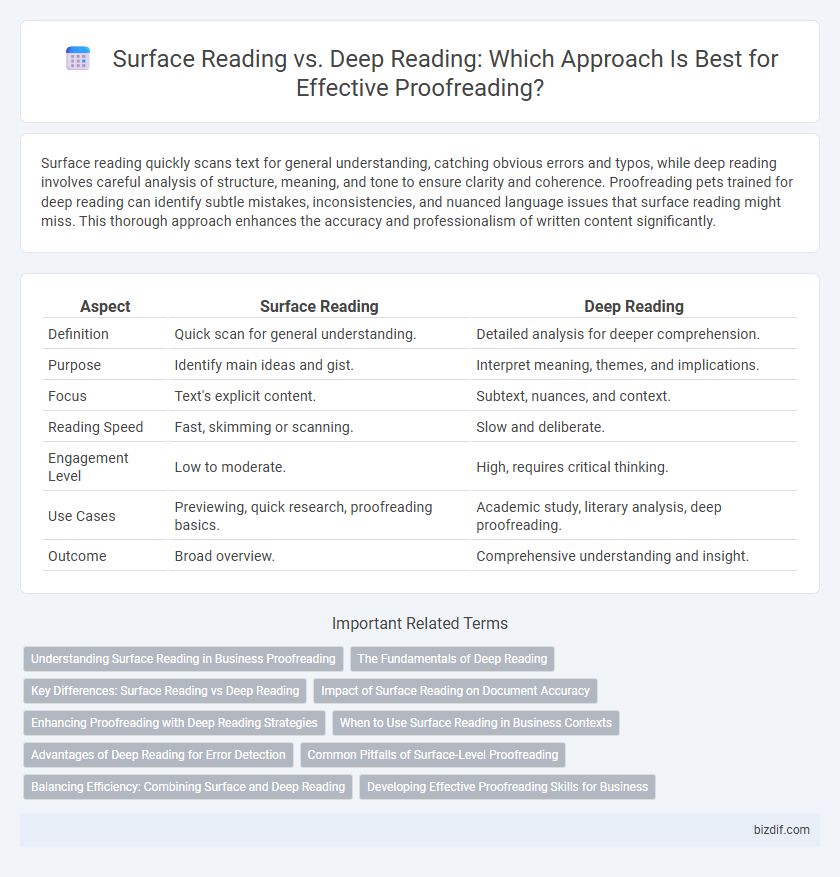Surface reading quickly scans text for general understanding, catching obvious errors and typos, while deep reading involves careful analysis of structure, meaning, and tone to ensure clarity and coherence. Proofreading pets trained for deep reading can identify subtle mistakes, inconsistencies, and nuanced language issues that surface reading might miss. This thorough approach enhances the accuracy and professionalism of written content significantly.
Table of Comparison
| Aspect | Surface Reading | Deep Reading |
|---|---|---|
| Definition | Quick scan for general understanding. | Detailed analysis for deeper comprehension. |
| Purpose | Identify main ideas and gist. | Interpret meaning, themes, and implications. |
| Focus | Text's explicit content. | Subtext, nuances, and context. |
| Reading Speed | Fast, skimming or scanning. | Slow and deliberate. |
| Engagement Level | Low to moderate. | High, requires critical thinking. |
| Use Cases | Previewing, quick research, proofreading basics. | Academic study, literary analysis, deep proofreading. |
| Outcome | Broad overview. | Comprehensive understanding and insight. |
Understanding Surface Reading in Business Proofreading
Surface reading in business proofreading involves quickly scanning documents to identify obvious errors like typos, formatting issues, and grammatical mistakes, ensuring the text appears professional and error-free. This method prioritizes clarity and consistency, crucial for maintaining brand reputation and effective communication in corporate settings. Mastery of surface reading enables proofreaders to efficiently polish business materials, supporting precise and polished presentations without delving into deeper content analysis.
The Fundamentals of Deep Reading
Deep reading involves intensive engagement with a text, focusing on comprehension, critical analysis, and reflection beyond surface-level understanding. It emphasizes cognitive processes such as inference, synthesis, and evaluation to uncover deeper meanings, author intentions, and nuanced arguments. Mastery of deep reading enhances the ability to recognize subtext, identify biases, and improve overall text interpretation, essential for thorough proofreading.
Key Differences: Surface Reading vs Deep Reading
Surface reading involves quickly skimming text to grasp main ideas and key points, prioritizing speed over comprehension depth. Deep reading requires slow, focused engagement with the material to analyze meaning, evaluate arguments, and understand nuances. This method enhances critical thinking and retention, making it essential for thorough proofreading and detailed textual analysis.
Impact of Surface Reading on Document Accuracy
Surface reading often leads to overlooked errors and misinterpretations, significantly reducing document accuracy during proofreading. This cursory approach fails to identify subtle grammatical nuances, contextual inconsistencies, and typographical mistakes crucial for precision. Rigorous proofreading demands deep reading to ensure comprehensive error detection and maintain high-quality, accurate documentation.
Enhancing Proofreading with Deep Reading Strategies
Deep reading techniques enhance proofreading accuracy by encouraging thorough engagement with the text, enabling detection of subtle errors in grammar, syntax, and meaning that surface reading often misses. Employing methods such as slow reading, annotation, and critical questioning improves comprehension and identification of inconsistencies, thereby producing a polished final text. Utilizing digital tools for highlighting and note-taking supports deep reading processes and further refines the proofreading workflow.
When to Use Surface Reading in Business Contexts
Surface reading is effective in business contexts for quickly scanning emails, reports, and presentations to capture key points without delving into details. It supports efficient decision-making by identifying essential information and action items in time-sensitive situations. Employ surface reading when the goal is to understand the gist or main message rather than analyze complex content.
Advantages of Deep Reading for Error Detection
Deep reading enhances error detection by promoting thorough engagement with the text, enabling the identification of subtle grammar mistakes, inconsistencies, and contextual inaccuracies that surface reading might overlook. This method improves comprehension and retention, allowing proofreaders to catch nuanced errors and ensure the content's overall coherence and accuracy. Deep reading also fosters critical thinking, which is essential for assessing tone, style, and logical flow during the proofreading process.
Common Pitfalls of Surface-Level Proofreading
Surface-level proofreading often overlooks errors in sentence structure, nuanced meaning, and thematic consistency, leading to misinterpretations and overlooked mistakes. Common pitfalls include focusing solely on spelling and grammar while ignoring context, tone, and flow, which are critical for high-quality academic or professional documents. This shallow approach can result in documents that are technically correct but semantically flawed, undermining the overall message and reader comprehension.
Balancing Efficiency: Combining Surface and Deep Reading
Balancing efficiency in proofreading requires integrating surface reading, which focuses on catching typographical errors and formatting issues, with deep reading that ensures comprehension and coherence at the content level. Employing a two-stage approach enhances accuracy by first eliminating superficial mistakes, followed by critical analysis to detect nuanced inconsistencies and logical flow errors. This method optimizes time management while maintaining high-quality, error-free documents.
Developing Effective Proofreading Skills for Business
Effective proofreading for business requires distinguishing between surface reading and deep reading methods to catch both typographical errors and contextual inconsistencies. Surface reading focuses on identifying spelling, grammar, and formatting issues quickly, while deep reading involves analyzing content for clarity, tone, and logical flow. Mastering both approaches enhances accuracy and professionalism in business communications, reducing misunderstandings and reinforcing brand credibility.
Surface Reading vs Deep Reading Infographic

 bizdif.com
bizdif.com